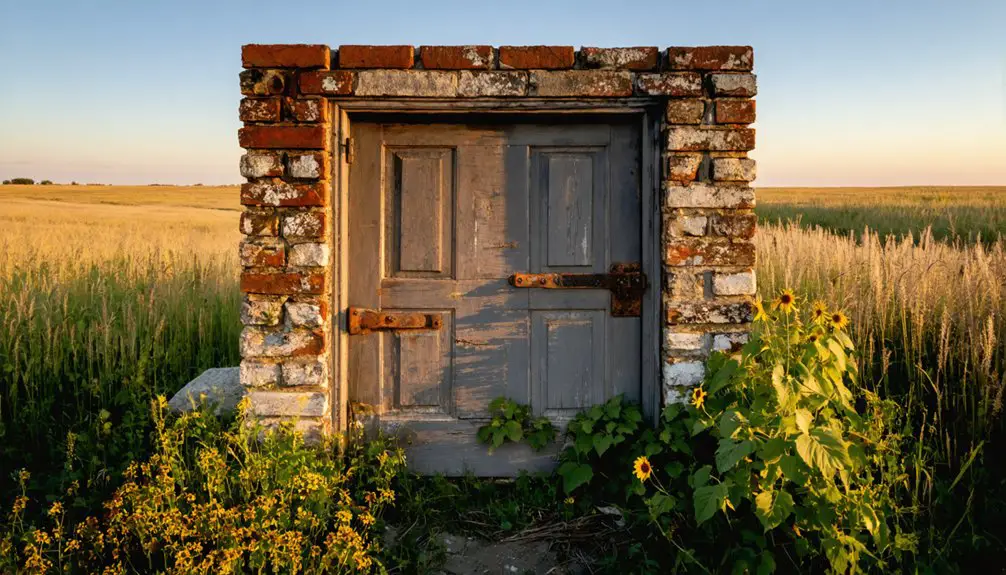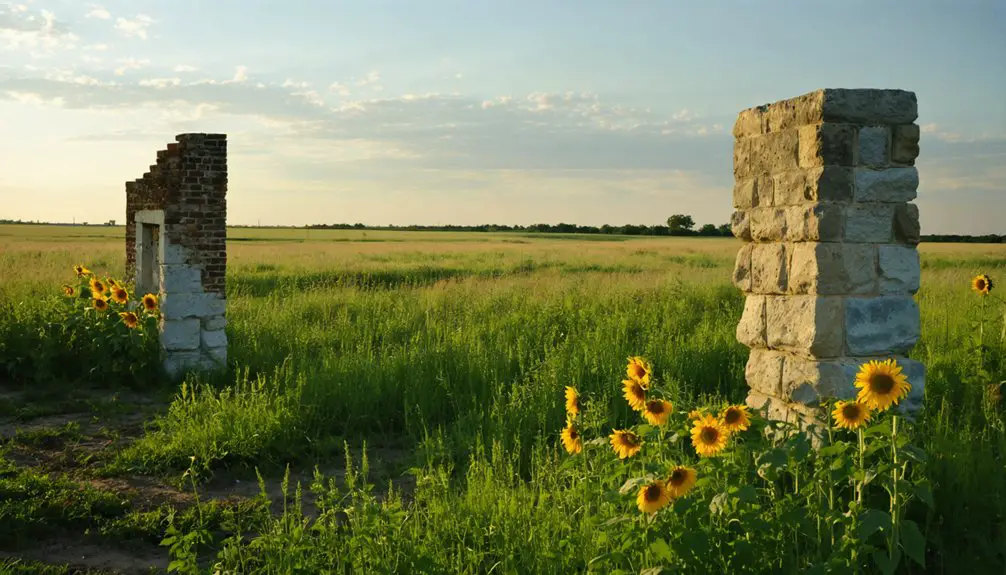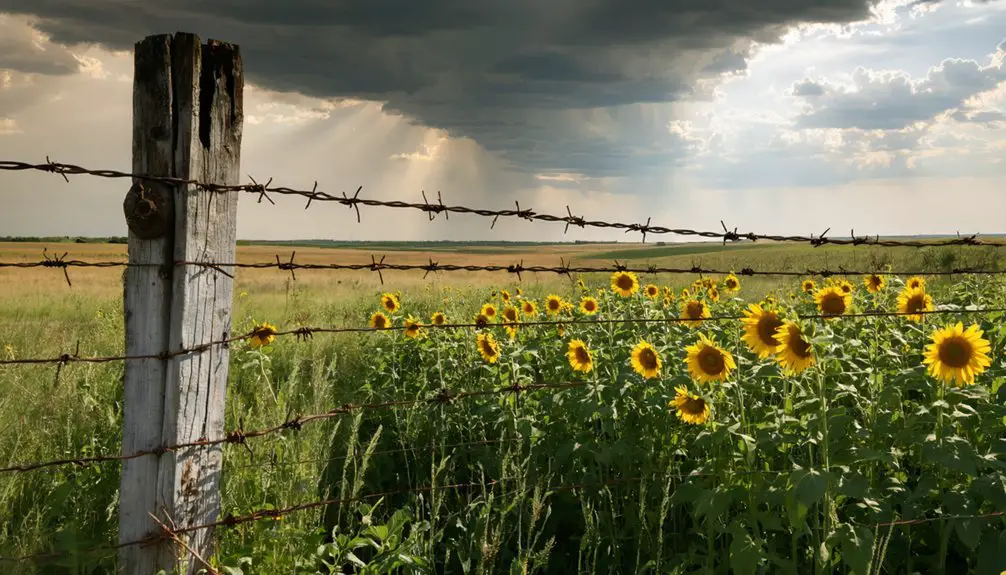You’ll find Octagon City‘s ghost town remains in Kansas, where the Vegetarian Kansas Emigration Company established an ambitious utopian settlement in 1855. Led by Henry S. Clubb, the community enforced strict vegetarianism, temperance, and anti-slavery values while featuring an innovative octagonal town design with eight radiating roads. Despite grand visions, the colony faced devastating challenges from disease, resource shortages, and violence, leading to its abandonment by 1857. The settlement’s fascinating story reveals deeper insights into America’s utopian experiment era.
Key Takeaways
- Octagon City was an 1856 vegetarian utopian settlement in Kansas that failed within a year, becoming a ghost town by 1857.
- The settlement’s unique design featured an octagonal town square with eight radiating roads intended to house 64 families.
- Disease, violence, harsh weather, and resource shortages led most settlers to abandon the community within months of arrival.
- Only four residents remained by 1857, and today no physical structures mark the location of this failed utopian experiment.
- The colony faced constant threats from Border Ruffians, Osage Native Americans, and severe health challenges including mosquito-borne illnesses.
A Bold Vision: The Vegetarian Kansas Emigration Company
In 1855, a group of idealistic reformers established the Vegetarian Kansas Emigration Company in New York with the ambitious goal of creating a flesh-free utopian settlement.
Led by British-American abolitionist Henry S. Clubb as secretary and Charles H. DeWolfe as president, the company’s utopian aspirations went far beyond dietary choices. You’ll find their constitution banned not just meat consumption but also slavery, alcohol, tobacco, and oath-taking.
The company adopted a joint-stock principle at their May 16th organizing meeting, allowing investments from $50 to $10,000 for shares representing future acreage. Dr. John McLaurin helped secure the settlement location by selecting a site along Neosho River.
Their vision of communal living attracted 47 initial settlers, with interest from America, England, and Scotland. They’d selected a site near the Neosho River in southeastern Allen County, planning an octagonal town that would showcase sustainable vegetarian principles. The settlement’s design included ambitious plans for a hydropathic establishment, agricultural college, and scientific institute.
The Octagonal Design: Architecture and Urban Planning
Drawing inspiration from Orson Squire Fowler’s architectural philosophy, Octagon City’s ambitious design centered around an octagonal town square with eight radiating roads.
The plan emphasized octagonal efficiency through its innovative housing designs, featuring central spiral staircases and wraparound verandas that facilitated natural airflow and movement. Fowler claimed these homes offered twenty percent more living space compared to traditional square houses. The settlement was designed to accommodate sixty-four families within its planned community layout.
You’d have found four spacious rooms on each floor of these octagonal houses, connected by doors that enhanced circulation. The architectural simplicity showcased tall windows for natural light, while the central cellar provided essential cold storage.
Though the irregular room shapes posed furniture placement challenges, the design prioritized function over decoration.
Form follows function in these octagonal homes, where practical living trumped the decorative concerns of traditional Victorian architecture.
The buildings were planned within a four-square-mile area, creating a symmetrical, sustainable community where every structure would contribute to the residents’ health and well-being through improved ventilation and spatial efficiency.
Life in the Settlement: Daily Struggles and Challenges
Daily life in Octagon City was marked by severe hardships, as settlers battled relentless mosquito-borne illnesses and malaria-like fevers that devastated families during their first winter.
Your chances of survival weren’t helped by the settlement’s dire lack of basic tools – with just one plow serving the entire colony and promised mills never materializing.
If you’d visited the settlement, you’d have found settlers struggling to endure in flimsy tents and cloth-covered shacks that offered little protection from the harsh Kansas elements.
Settlers faced additional challenges when crop theft by local tribes threatened their already limited food supplies.
Despite the challenges, the settlement was established on principles of socially moral living, emphasizing vegetarianism and sustainable practices.
Disease and Poor Health
Life in Octagon City became increasingly dire as settlers faced a devastating array of health challenges that would ultimately contribute to the settlement’s downfall.
Without proper disease prevention measures or health infrastructure, you’d find yourself battling constant threats from mosquito-borne illnesses and malaria-like conditions. The remote location meant you couldn’t easily access medical care from Fort Scott or other nearby towns.
Your struggles would intensify as springs dried up, leaving you with scarce clean water. You’d witness your fellow settlers succumbing to malnutrition, exhaustion, and severe flu-like epidemics, especially during the harsh winter months. Settler Miriam Davis Colt captured these hardships in her detailed account Went to Kansas.
Poor shelter offered little protection from the elements, while continuous thunderstorms and flooding only worsened your health conditions.
Limited Tools and Resources
Three critical resource shortages crippled daily life in Octagon City from the start.
First, you’d find agricultural shortages everywhere – the promised farming equipment never materialized beyond a single plow for the entire settlement.
Second, you’d struggle with inadequate infrastructure, as settlers lived in canvas tents and makeshift shacks while promised permanent buildings remained unbuilt.
Third, you’d face severe water scarcity when the springs unexpectedly dried up, leaving both drinking and farming needs unmet.
Resource mismanagement amplified these hardships.
You couldn’t process crops without the promised sawmill and grist mill, and you’d have to share just two ovens among all settlers.
When plumbing systems failed, no repairs came, forcing the settlement to hire outside help – a final blow to their cooperative vision.
Inadequate Housing Conditions
Despite grand promises of octagonal homes and modern infrastructure, settlers arriving at Octagon City in May 1856 found only a single log cabin and scattered tents to house approximately 100 people.
You’d have faced severe shelter inadequacies as most settlers were forced to live outdoors or in makeshift shelters, exposed to harsh weather and seasonal changes. The community’s lone octagonal dwelling quickly became overcrowded, while the tents offered little protection from storms, heat, or cold.
Without proper building materials or repair equipment, you couldn’t have improved these primitive living conditions.
The settler hardships were compounded by damp environments and poor ventilation in the overcrowded spaces.
These housing failures ultimately contributed to the settlement’s rapid decline, as disappointed colonists abandoned their dreams of a progressive community.
Social Ideals and Community Values

While Octagon City’s founders initially required strict vegetarianism from all settlers, you’ll find that economic pressures forced them to broaden their acceptance to include non-vegetarians who shared their other moral ideals.
You can trace how this shift allowed the community to maintain its core values of temperance, anti-slavery sentiment, and commitment to family education while adapting to practical realities.
The settlement’s evolution from exclusive dietary restrictions to broader moral reforms demonstrates how the community attempted to balance its utopian vision with the need for sustainable growth.
Vegetarian Values Evolve
As the early 19th century ushered in an era of social reform, vegetarianism emerged as a movement deeply intertwined with moral causes like pacifism, abolition, and women’s suffrage.
Led by visionaries like Reverend William Cowherd and supported by ethical philosophers such as Jeremy Bentham, vegetarianism became foundational to broader humanitarian ideals. The American Vegetarian Society was established in 1850, promoting meatless diets alongside social reforms. Dr. William Lambe adopted a plant food-only diet in 1806, inspiring future generations of vegetarian advocates.
You’ll find these key developments shaped the movement’s evolution:
- The 1847 formation of England’s Vegetarian Society institutionalized organized advocacy.
- America’s vegetarian societies aligned with social reform movements in the 1850s.
- The 1908 International Vegetarian Union expanded these principles globally.
- The 1944 emergence of veganism marked a shift toward complete animal liberation.
This progression reflected growing awareness that dietary choices fundamentally connected to social justice and moral progress.
Unity Through Moral Reform
The moral reform vision that shaped Octagon City, Kansas emerged from the broader vegetarian movement‘s alignment with social progress. You’ll find that founder Henry S. Clubb’s vision went beyond dietary choices, embracing anti-slavery ideals, communal living, and alcohol abstinence as pillars of moral education.
At its core, the settlement required residents to take an oath promising community engagement and proper child education. The settlement’s values were influenced by Clubb’s early involvement with the Swedenborgian sect.
While the community restricted membership based on race and class, it did adapt some ideals – like allowing non-vegetarians – to attract more settlers.
The town’s unique octagonal design, with its central square and eight radiating roads, symbolized the interconnectedness they sought.
Despite these aspirations for unity through shared values, external threats from pro-slavery groups and internal conflicts over resources ultimately fractured their moral reform experiment.
The Colony’s Downfall and Abandonment
Despite ambitious plans for an octagonal utopian settlement, Octagon City‘s downfall began almost immediately upon the arrival of its first 100 settlers in 1856.
Failed expectations hit hard as settlers found just one log cabin instead of the promised octagonal houses, and critical infrastructure like sawmills never materialized.
The colony’s rapid decline stemmed from:
The promised utopia crumbled swiftly under the weight of disease, violence, harsh weather, and inadequate resources.
- Devastating health crises from mosquito-borne illnesses and malnutrition
- Constant threats from Border Ruffians and conflicts with Osage Native Americans
- Harsh environmental conditions including severe storms and unreliable water sources
- Complete lack of promised agricultural resources with only one plow available
The settler exodus was swift and decisive. By 1857, only four residents remained, and the site gradually deteriorated into a ghost town, with its physical remnants succumbing to vandalism and neglect by 2007.
Historical Impact and Modern-Day Remnants

While Octagon City‘s physical presence vanished swiftly, its lasting influence on American utopian movements, vegetarianism, and social reform endured well beyond its brief existence.
The colony’s cultural influences rippled through the nation as former residents joined abolitionist causes and spread vegetarian ideals. Henry Clubb’s leadership of the American Vegetarian Society amplified these impacts nationwide.
Today, you’ll find no octagonal structures marking the settlement’s location, yet the community dynamics that shaped Octagon City continue to inspire modern intentional communities.
The experiment’s architectural vision, though unfulfilled, remains a fascinating example of geometric urban planning in American communal ventures.
Former colonists’ subsequent involvement in Kansas’s turbulent border conflicts and social reform movements demonstrates how this failed utopia catalyzed broader regional change.
Frequently Asked Questions
What Happened to Henry S. Clubb After Leaving Octagon City?
After a million setbacks from Octagon City, you’ll find Henry Clubb continued promoting vegetarianism until his death in 1921. His legacy lives on through his tireless advocacy for meat-free living.
Were Any Artifacts or Personal Belongings Recovered From the Settlement Site?
You won’t find documented artifact discoveries from the settlement site. Historical records don’t show any personal history items recovered, despite abundant Native American artifacts found in surrounding Kansas regions.
Did Any Descendants of Original Settlers Return to Visit Octagon City?
While you’d expect descendant visits to be well-documented, there’s no historical evidence of family connections returning to the site. Records show the settlement remained largely abandoned, deterring potential pilgrimages through modern times.
What Was the Total Financial Loss Incurred by Investors?
You’d find the financial implications of Octagon City’s investment failures resulted in complete loss of capital, likely totaling thousands of 1850s dollars (hundreds of thousands in today’s value) for 100 settlers.
How Did Nearby Established Communities React to Octagon City’s Founding?
You’d find neighboring towns viewed the settlement with deep skepticism, doubting its vegetarian principles and survival odds. The community response was largely critical, seeing it as impractical and poorly planned.
References
- https://www.messynessychic.com/2019/10/03/that-time-vegetarians-were-considered-so-batshit-they-only-belonged-in-isolated-utopian-communes/
- http://genealogytrails.com/kan/allen/vegetariancolonykansas.html
- https://en.wikipedia.org/wiki/Octagon_City
- https://www.atlasobscura.com/places/sad-saga-of-vegetarian-creek
- https://www.chartistancestors.co.uk/henry-clubb-1827-1921/
- https://www.ksgenweb.org/archives/1912/v/vegetarian_settlement_co.html
- https://www.kancoll.org/khq/1933/33_4_hickman.htm
- https://www.ivu.org/history/usa19/clubb.html
- http://www.kancoll.org/articles/stewart/ws_section04.htm
- https://www.messynessychic.com/2022/04/12/how-america-became-enamoured-with-octagon-houses/



